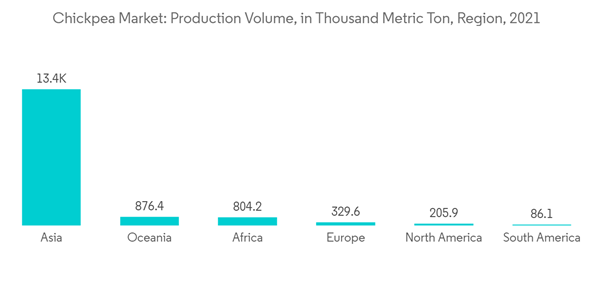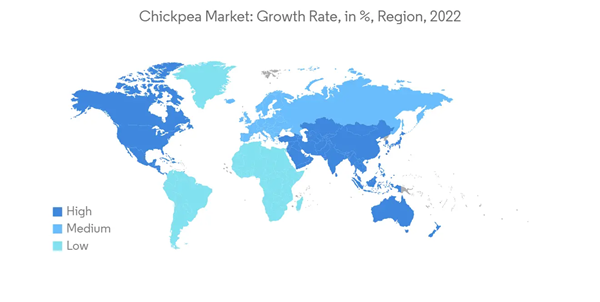The Chickpea Market size is estimated at USD 9.44 billion in 2024, and is expected to reach USD 11.02 billion by 2029, growing at a CAGR of 3.15% during the forecast period (2024-2029).
India is the largest country in terms of Chickpea production. Over recent years, the area under chickpea cultivation in the country has significantly increased. For instance, according to Food and Agriculture Organization (FAO) data, the area under chickpea cultivation was 9.6 million ha in 2019 in India, which increased to 10.9 million ha in 2021.
According to the FAO, in 2021, India, Australia, Ethiopia, Turkey, Myanmar, and Russia were the prominent producers of chickpeas, accounting for 11,910.0 thousand metric ton, 876.4 thousand metric ton, 478.2 thousand metric ton, 475.0 thousand metric ton, 467.3 thousand metric ton, and 316.8 thousand metric ton, respectively. The growing awareness about healthy products is expected to drive the market during the forecast period as chickpeas are highly nutritional.
Chickpeas are used as snacks in many parts of the world and even in salads. Changing lifestyles and increased awareness regarding healthy eating are expected to fuel the market growth over the forecast period. Chickpeas are rich sources of fiber, folate, zinc, and protein. For instance, in Turkey, salted roasted chickpeas are consumed as "Leblebi," spiced with cloves. In South Asia, chickpeas are mostly consumed as snacks and as curry.
According to the ITC Trademap, the export volume from India occupied by the major importers, such as the United Arab Emirates with 32,205 metric ton, Iran with 6,604 metric ton, Saudi Arabia with 6,144 metric ton, the United States with 3,697 metric ton, and China with 2,755 metric ton.
Many companies are introducing innovative snack products made from chickpeas in the market to support health consciousness across the world. The demand for chickpea-based snacks is rising in many parts of the world. For example, in November 2022, Biena Snacks launched Tasty Thins, a line of crisps formulated with chickpeas. This stimulated demand has resulted in the rising imports of chickpeas across the world.
This product will be delivered within 2 business days.
Key Highlights
- Chickpea (Cicer arietinum) is one of the major pulses cultivated and consumed worldwide. It is one of the oldest and most important sources of protein. After dry beans and peas, chickpea is the third most important pulse crop grown in the world. Chickpea accounts for 20% of global pulse production.
- According to the FAO, in 2021, India, Pakistan, Australia, Turkey, and Myanmar had the highest area harvested land for chickpeas, accounting for 10,943.6 thousand ha, 882.7 thousand ha, 606.3 thousand ha, 481.6 thousand ha, and 439.8 thousand ha, respectively.
- Increasing consumption of chickpeas as snacks in developed countries is expected to boost the market during the forecast period. The Asia-Pacific region is projected to register the highest growth rate during the forecast period as India is the largest producer and consumer of chickpeas, accounting for approximately 8 million metric ton of production annually, which is 70% of global chickpea production.
- The import of chickpeas has increased significantly, along with production. Suppliers have profited from increased demand through production and price development. Chickpeas are becoming more regular and convenient in ready-to-eat meals, salads, and snacks. The growing popularity of these products provides opportunities for more imports and product differentiation, driving the overall chickpea market.
Chickpea Market Trends
Increasing Production Due to Health Benefits
Chickpeas are an affordable source of nutritional protein for vegetarians and are extensively consumed in the Indian subcontinent as curries. As a result of growing health awareness, consumers increasingly prefer products with high protein content, driving chickpea demand even higher. The production of chickpeas is also rising in the country. For instance, as per FAO data, 11.3 million metric ton of chickpeas were produced in the country in 2018, which increased to 11.9 million metric ton in 2021.India is the largest country in terms of Chickpea production. Over recent years, the area under chickpea cultivation in the country has significantly increased. For instance, according to Food and Agriculture Organization (FAO) data, the area under chickpea cultivation was 9.6 million ha in 2019 in India, which increased to 10.9 million ha in 2021.
According to the FAO, in 2021, India, Australia, Ethiopia, Turkey, Myanmar, and Russia were the prominent producers of chickpeas, accounting for 11,910.0 thousand metric ton, 876.4 thousand metric ton, 478.2 thousand metric ton, 475.0 thousand metric ton, 467.3 thousand metric ton, and 316.8 thousand metric ton, respectively. The growing awareness about healthy products is expected to drive the market during the forecast period as chickpeas are highly nutritional.
Asia-Pacific Dominates Chickpea Exports
The surging production and consumption of chickpeas in the Asia-Pacific region, majorly in India, is driving the market's growth. India holds a significant share in the development of chickpeas across the region due to its increasing production and export worldwide. The growing urban population, changing lifestyles, increasing household incomes, and changing consumer tastes and preferences are driving the demand for chickpeas in Asia-Pacific.Chickpeas are used as snacks in many parts of the world and even in salads. Changing lifestyles and increased awareness regarding healthy eating are expected to fuel the market growth over the forecast period. Chickpeas are rich sources of fiber, folate, zinc, and protein. For instance, in Turkey, salted roasted chickpeas are consumed as "Leblebi," spiced with cloves. In South Asia, chickpeas are mostly consumed as snacks and as curry.
According to the ITC Trademap, the export volume from India occupied by the major importers, such as the United Arab Emirates with 32,205 metric ton, Iran with 6,604 metric ton, Saudi Arabia with 6,144 metric ton, the United States with 3,697 metric ton, and China with 2,755 metric ton.
Many companies are introducing innovative snack products made from chickpeas in the market to support health consciousness across the world. The demand for chickpea-based snacks is rising in many parts of the world. For example, in November 2022, Biena Snacks launched Tasty Thins, a line of crisps formulated with chickpeas. This stimulated demand has resulted in the rising imports of chickpeas across the world.
Additional Benefits:
- The market estimate (ME) sheet in Excel format
- 3 months of analyst support
This product will be delivered within 2 business days.
Table of Contents
1 INTRODUCTION
4 MARKET DYNAMICS
5 MARKET SEGMENTATION










